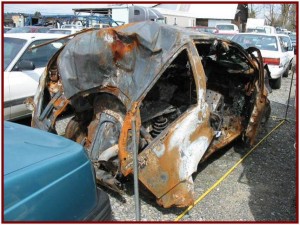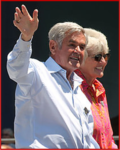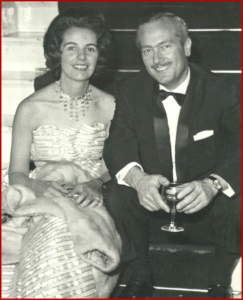 Road Fatalities: US Road Fatalities were the Grim Reaper rampant during 2021. NHTSA’s Early Estimate of Motor Vehicle Traffic Fatalities for the First Half (January-June) of 2021, showed the largest six-month increase ever recorded in the Fatality Analysis Reporting System’s history. An estimated 20,160 people in the US died in motor vehicle crashes in the first half of 2021, up 18.4% over 2020. That’s the largest number of projected fatalities in that time period since 2006. The fatality rate for the first half of 2021 increased to 1.34 fatalities per 100 million VMT, up from the projected rate of 1.28 fatalities per 100 million VMT in the first half of 2020.
Road Fatalities: US Road Fatalities were the Grim Reaper rampant during 2021. NHTSA’s Early Estimate of Motor Vehicle Traffic Fatalities for the First Half (January-June) of 2021, showed the largest six-month increase ever recorded in the Fatality Analysis Reporting System’s history. An estimated 20,160 people in the US died in motor vehicle crashes in the first half of 2021, up 18.4% over 2020. That’s the largest number of projected fatalities in that time period since 2006. The fatality rate for the first half of 2021 increased to 1.34 fatalities per 100 million VMT, up from the projected rate of 1.28 fatalities per 100 million VMT in the first half of 2020.
“This is a crisis. More than 20,000 people died on U.S. roads in the first six months of 2021, leaving countless loved ones behind. We cannot and should not accept these fatalities as simply a part of everyday life in America,” said United States Transportation Secretary Pete Buttigieg.

Bobby Unser 1934-2021.
Unsers: Three members of a Racing Royalty family passed during a year when racing like every day life was tumultuous. Thankfully none of the Unsers passed from Covid.
Bobby Unser in June 2021 and his son, Bobby Unser Jr. (who passed six weeks after his father). Al Unser (May 29, 1939-December 9, 2021), one of only four drivers to win the Indianapolis 500 a record four times also died.
Al won the Indy 500 Four Times in 1970, 1971, 1978, and 1987, at age 47, making him the oldest winner in Indy 500 history. He is also the only driver in history to have both a brother and a child win at The Brickyard. He made 27 starts in the Indy 500, the third most in history.

Al Unser 1939-2021.
AL Unser and son Al Jr.were the first father-son pairing at Indianapolis. During 1985 they raced against one another for the CART championship, which Unser Senior won by a single point. He was tearful describing the “empty feeling” of defeating his son. Al Unser senior also ran five NASCAR races in his career, finishing fourth in the 1968 Daytona 500. He earned three top-10 finishes in NASCAR. He also won three times in the International Race of Champions, a celebrity racing series with drivers from various segments racing against each other in allegedly identical cars.
Unser Senior was inducted into the Indianapolis Motor Speedway Hall of Fame in 1986 and the International Motorsports Hall of Fame in 1998. His collection of trophies and cars is housed at the Unser Racing Museum in Albuquerque.
 Lotus: Hazel Williams was born on the 21 May 1927 in North London. She met Colin Chapman at a dance in 1944 when he was just 16 and she a few months older. As the couple’s relationship developed, Hazel’s parents allowed Colin to build what became the first Lotus – the Mark 1 – in the lock-up garage at the back of their house in Hornsey.
Lotus: Hazel Williams was born on the 21 May 1927 in North London. She met Colin Chapman at a dance in 1944 when he was just 16 and she a few months older. As the couple’s relationship developed, Hazel’s parents allowed Colin to build what became the first Lotus – the Mark 1 – in the lock-up garage at the back of their house in Hornsey.
Colin gained a commission into the Royal Air Force, so Hazel continued with the building of the Lotus Mark 1 and then the Mark 2. Competition success in races entered by Hazel and Colin resulted in new commissions for their automotive services. Their first Lotus business was formed on 1 January 1952. It became a limited company later in the year, funded by payment of £25 from Hazel. Hazel and Colin married in 1954. As the business grew Hazel took a seat on the board of a number of their companies, including Lotus Cars, Team Lotus and Lotus Components.
Bruce Meyer: A self-described beach bum, Bruce Meyers (March 12, 1926-Feb. 19, 2021) attended art school and built boats, learning to design with fiberglass. In the early 1960s, Meyers designed an off-road vehicle that became an icon for California surfers, beach bums, and off-road racers – The Dune Buggy. He was a California hot-rodder and free spirit who apparently didn’t think much of ‘34 wagons that they – or the Beach Boys – called woodies.
The Manx formula: lightweight fiberglass body atop four giant wheels, with a pair of bug-eye head lamps and space for a surfboard, powered by readily available VW flat four air-cooled engines or for real hot rodders 911 engines. The Meyers Manx was popular. It went GOLD so-to-speak when Meyers’ first dune buggy, dubbed Old Red, won a 1,000-mile off-road race in Mexico in record time. That race became known as the BAJA 1000.
More than 6,000 Meyers Manx dune buggies were built by B.F. Meyers & Co. Roughly 300,000 dune buggies were built by competitors, maybe many more. In 1976 Road &Track Magazine called the Manx “one of the most significant and influential cars of all time … recognized as a genuine sculpture, a piece of art.” Meyers shut his company in 1971 after losing a copyright/intellectual property lawsuit. But stayed active working through other companies.

About Ken Zino
Ken Zino, editor and publisher of AutoInformed, is a versatile auto industry participant with global experience spanning decades in print and broadcast journalism, as well as social media. He has automobile testing, marketing, public relations and communications experience. He is past president of The International Motor Press Assn, the Detroit Press Club, founding member and first President of the Automotive Press Assn. He is a member of APA, IMPA and the Midwest Automotive Press Assn.
He also brings an historical perspective while citing their contemporary relevance of the work of legendary auto writers such as Ken Purdy, Jim Dunne or Jerry Flint, or writers such as Red Smith, Mark Twain, Thomas Jefferson – all to bring perspective to a chaotic automotive universe.
Above all, decades after he first drove a car, Zino still revels in the sound of the exhaust as the throttle is blipped during a downshift and the driver’s rush that occurs when the entry, apex and exit points of a turn are smoothly and swiftly crossed. It’s the beginning of a perfect lap.
AutoInformed has an editorial philosophy that loves transportation machines of all kinds while promoting critical thinking about the future use of cars and trucks.
Zino builds AutoInformed from his background in automotive journalism starting at Hearst Publishing in New York City on Motor and MotorTech Magazines and car testing where he reviewed hundreds of vehicles in his decade-long stint as the Detroit Bureau Chief of Road & Track magazine. Zino has also worked in Europe, and Asia – now the largest automotive market in the world with China at its center.


Notable Deaths During 2021
“This is a crisis. More than 20,000 people died on U.S. roads in the first six months of 2021, leaving countless loved ones behind. We cannot and should not accept these fatalities as simply a part of everyday life in America,” said United States Transportation Secretary Pete Buttigieg.
Bobby Unser 1934-2021.
Unsers: Three members of a Racing Royalty family passed during a year when racing like every day life was tumultuous. Thankfully none of the Unsers passed from Covid.
Bobby Unser in June 2021 and his son, Bobby Unser Jr. (who passed six weeks after his father). Al Unser (May 29, 1939-December 9, 2021), one of only four drivers to win the Indianapolis 500 a record four times also died.
Al won the Indy 500 Four Times in 1970, 1971, 1978, and 1987, at age 47, making him the oldest winner in Indy 500 history. He is also the only driver in history to have both a brother and a child win at The Brickyard. He made 27 starts in the Indy 500, the third most in history.
Al Unser 1939-2021.
AL Unser and son Al Jr.were the first father-son pairing at Indianapolis. During 1985 they raced against one another for the CART championship, which Unser Senior won by a single point. He was tearful describing the “empty feeling” of defeating his son. Al Unser senior also ran five NASCAR races in his career, finishing fourth in the 1968 Daytona 500. He earned three top-10 finishes in NASCAR. He also won three times in the International Race of Champions, a celebrity racing series with drivers from various segments racing against each other in allegedly identical cars.
Unser Senior was inducted into the Indianapolis Motor Speedway Hall of Fame in 1986 and the International Motorsports Hall of Fame in 1998. His collection of trophies and cars is housed at the Unser Racing Museum in Albuquerque.
Colin gained a commission into the Royal Air Force, so Hazel continued with the building of the Lotus Mark 1 and then the Mark 2. Competition success in races entered by Hazel and Colin resulted in new commissions for their automotive services. Their first Lotus business was formed on 1 January 1952. It became a limited company later in the year, funded by payment of £25 from Hazel. Hazel and Colin married in 1954. As the business grew Hazel took a seat on the board of a number of their companies, including Lotus Cars, Team Lotus and Lotus Components.
Bruce Meyer: A self-described beach bum, Bruce Meyers (March 12, 1926-Feb. 19, 2021) attended art school and built boats, learning to design with fiberglass. In the early 1960s, Meyers designed an off-road vehicle that became an icon for California surfers, beach bums, and off-road racers – The Dune Buggy. He was a California hot-rodder and free spirit who apparently didn’t think much of ‘34 wagons that they – or the Beach Boys – called woodies.
The Manx formula: lightweight fiberglass body atop four giant wheels, with a pair of bug-eye head lamps and space for a surfboard, powered by readily available VW flat four air-cooled engines or for real hot rodders 911 engines. The Meyers Manx was popular. It went GOLD so-to-speak when Meyers’ first dune buggy, dubbed Old Red, won a 1,000-mile off-road race in Mexico in record time. That race became known as the BAJA 1000.
More than 6,000 Meyers Manx dune buggies were built by B.F. Meyers & Co. Roughly 300,000 dune buggies were built by competitors, maybe many more. In 1976 Road &Track Magazine called the Manx “one of the most significant and influential cars of all time … recognized as a genuine sculpture, a piece of art.” Meyers shut his company in 1971 after losing a copyright/intellectual property lawsuit. But stayed active working through other companies.
About Ken Zino
Ken Zino, editor and publisher of AutoInformed, is a versatile auto industry participant with global experience spanning decades in print and broadcast journalism, as well as social media. He has automobile testing, marketing, public relations and communications experience. He is past president of The International Motor Press Assn, the Detroit Press Club, founding member and first President of the Automotive Press Assn. He is a member of APA, IMPA and the Midwest Automotive Press Assn. He also brings an historical perspective while citing their contemporary relevance of the work of legendary auto writers such as Ken Purdy, Jim Dunne or Jerry Flint, or writers such as Red Smith, Mark Twain, Thomas Jefferson – all to bring perspective to a chaotic automotive universe. Above all, decades after he first drove a car, Zino still revels in the sound of the exhaust as the throttle is blipped during a downshift and the driver’s rush that occurs when the entry, apex and exit points of a turn are smoothly and swiftly crossed. It’s the beginning of a perfect lap. AutoInformed has an editorial philosophy that loves transportation machines of all kinds while promoting critical thinking about the future use of cars and trucks. Zino builds AutoInformed from his background in automotive journalism starting at Hearst Publishing in New York City on Motor and MotorTech Magazines and car testing where he reviewed hundreds of vehicles in his decade-long stint as the Detroit Bureau Chief of Road & Track magazine. Zino has also worked in Europe, and Asia – now the largest automotive market in the world with China at its center.